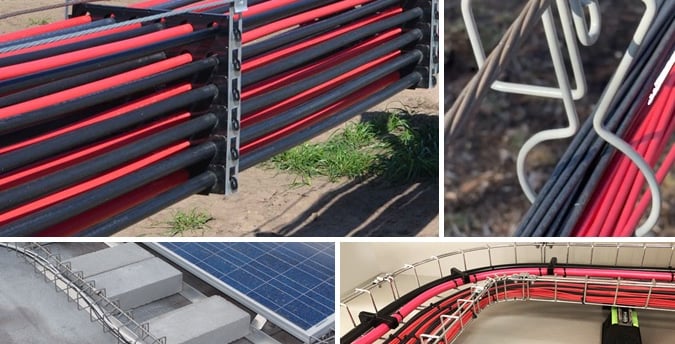Wire Management Failures in Solar: Real Lessons from the Field
When it comes to solar installations, everyone loves to talk about racking, string sizing, and inverter selection—but if one area consistently gets overlooked (until it’s too late), it’s wire management. Whether you’re stringing panels on a residential roof or laying down miles of cable in a utility-scale array, poor wire management will come back to haunt you. As a master electrician who’s seen thousands of installations over the years, let me tell you—that the panels or the inverters didn’t cause most solar system failures I’ve encountered. They were caused by sloppy, lazy, or outright negligent wire management. Let’s walk through some real-world lessons from the field—and how to avoid repeating the same mistakes.
PRO ACCESS
4/10/20253 min read


Lesson 1: Zip Ties Aren’t Forever
One of the most common rookie mistakes in solar installs is relying on standard nylon zip ties in outdoor environments. I’ve seen entire strings brought offline because of degraded ties that snapped under UV exposure.
Field Example:
On a 4MW utility project in Texas, contractors used non-UV-rated ties to secure home runs under the array. Within a year, the desert sun turned those ties brittle, and the wires sagged into sharp steel edges on the racking. Insulation damage led to ground faults, tripping the inverters, and taking out multiple combiner boxes. The site suffered a 12% production loss for weeks during peak summer.
Fix:
Use UV-resistant ties rated for long-term outdoor use, or ditch plastic altogether. Use solar-specific clips or metal cable hangers designed to survive 25+ years in extreme conditions.
Lesson 2: Sagging Cables Kill Systems
It doesn’t take much for a dangling wire to chafe through its insulation. Even a gentle breeze can cause wires to sway and rub on mounting hardware over time.
Field Example:
During a walkthrough on a 500kW commercial rooftop, I spotted sagging strings under the array. A closer look revealed half a dozen conductors resting on the rough edge of the rail. Two strings failed insulation testing, and one conductor shorted out the panel optimizers.
Fix:
Support conductors at regular intervals—typically every 18 to 24 inches for string wires, per manufacturer specs. NEC 2023 doesn’t give a hard number here, but 690.31(C)(1) makes it clear that conductors must be “secured and protected.” Use clips that lock the wire in place and don’t allow lateral movement.
Lesson 3: Cable Trays Aren’t Dumping Grounds
On large-scale projects, cable trays are the backbone of organized wire runs—but only if they’re used properly. I’ve seen trays overloaded, open to rain, and stuffed like spaghetti pots.
Field Example:
On a 10MW tracker site, installers routed DC feeders and AC conductors through the same tray. Not only did this violate NEC 300.3(C)(1), but it also created a nightmare of electromagnetic interference and led to false inverter readings. Worse, the tray filled with water during rains due to poor drainage planning, eventually corroding multiple terminations.
Fix:
Separate AC and DC conductors unless the facility is specifically rated for mixed-use. Install weep holes or open-mesh tray bottoms for drainage, and always follow NEC 392 for cable tray systems, including fill capacity and support spacing.
Lesson 4: Rodents Love Your Mistakes
If you leave gaps, sagging wires, or easy access under your array, don’t be surprised when wildlife moves in.
Field Example:
A 200kW ground-mount had multiple string failures within a year. After insulation resistance testing and a thermal scan, we found chew marks at several string fuses and connectors. Rabbits had taken up residence under the array, drawn in by the warmth and shelter—and the installer had left exposed cable loops hanging just inches off the ground.
Fix:
Use rodent barriers, keep conductors off the ground, and minimize slack. Conduits or armor for vulnerable sections are worth every penny. NEC 300.4 gives guidance on protecting conductors from physical damage—especially in exposed locations.
Lesson 5: Poor Terminations Undermine Everything
A neatly dressed but poorly terminated cable is still a failure waiting to happen. Bad crimps, exposed copper, or overtightened lugs plague solar sites.
Field Example:
We traced a system shutdown to a melted MC4 connector on a rooftop array. A quick inspection showed that the contact pin hadn’t been fully seated during termination—likely done in a rush without the proper tool. The result? A high-resistance connection that arced and melted under load.
Fix:
Train your team on proper termination methods and inspect EVERY connector. Use the proper crimping tools for the manufacturer’s contacts, and torque check everything per spec. Label and document your QC process—especially when working with subcontractors.
Final Thoughts: Wire Management Is Production Insurance
You can install the most efficient modules and the best inverters on the market—but if your wire management sucks, you’re throwing away kilowatt-hours. And worse, you’re setting up the client for a lifetime of maintenance issues.
Proper wire management isn’t about being tidy—it’s about longevity, safety, and code compliance. NEC Article 690 lays out the framework, but real-life success depends on discipline, training, and a quality culture.
Don’t just install wires. Manage them like your system’s performance depends on them—because it does.
ShockTalk: Your Code-Safe Guide
We help electricians, contractors, and DIYers build safer systems with real-world electrical expertise and simplified NEC guidance.
Expertise
Want Tips from a Master Electrician?
Email: info@shocktalk.org
Support Hours: Mon–Fri, 8am–6pm CST
817-716-1579
© 2025. All rights reserved.
